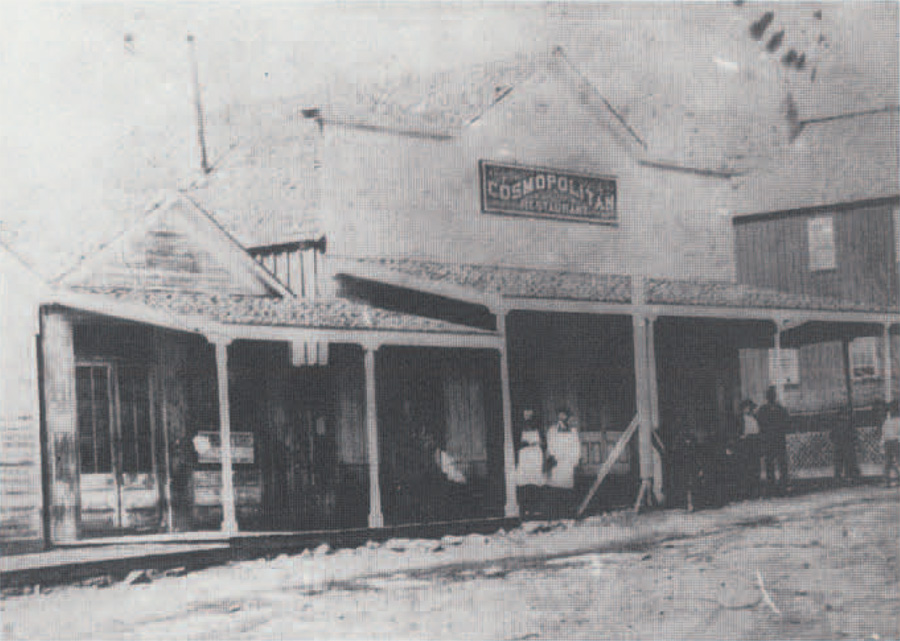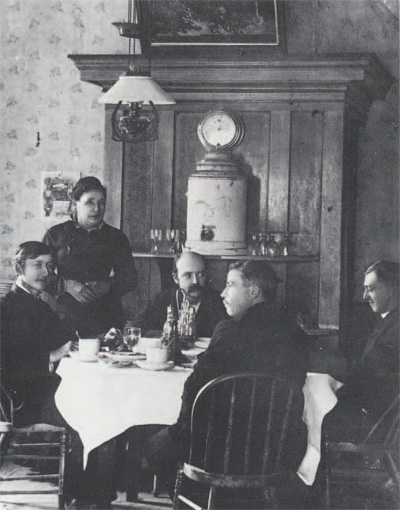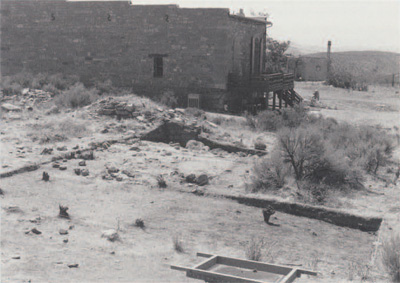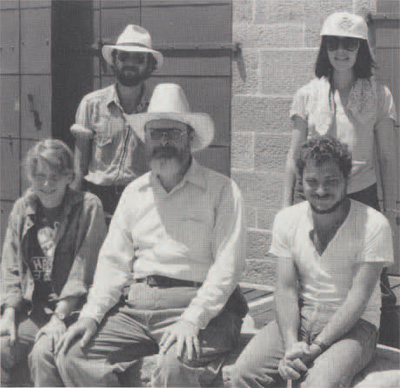
Since 1981 the American Historical Archaeology Section of The University Museum has been running a project that alternates between digging in the ground and digging into archives. The Silver Reef Project is the first attempt to create an “historic ethnography”—as complete as possible a cultural reconstruction—of an American mining boom town in the 1870s and 1880s. Equal attention has been given to the physical remains of Silver Reef, its few standing ruins, numerous foundations, archaeological deposits and overall settlement pattern, and to the surprisingly extensive written records produced by the town’s inhabitants. Starting with an initial two week visit-survey to southwestern Utah in 1980, during which over twenty potential sites including the ghost town at Silver Reef, were reviewed, the project sequence over the last seven years has moved between field and archival research:

Fieldwork: The site was mapped and extensive surface collecting carried out. Buildings excavated so far include the Elk Horn Saloon (ca. 1877-91), the Case-Wagner Drug Store (ca. 1877-90), and the backyard of the Cosmopolitan Restaurant (ca. 1877-95; see below).
Archival: Surveys have been made of all official documents relating to Silver Reef residing in the Utah State-Territorial Archives in Salt Lake City and in the Washington County archive in St. George. Abstraction of all mining claims for the area around the town, and copying of all land and property transactions have been carried out. Secondary repositories in Indiana and California were also visited.
From Boom Town to Ghost Town
An ethnographic view of 19th century Silver Reef can take either of two very different perspectives: local or global. Silver Reef was a discrete community and an examination of its archaeological remains immediately draws its boundaries. It was spatially set off from adjacent sites, including Leeds, the small Mormon village only a mile away. Culturally it was also set off in the 19th century, as a “Gentile” or non-Mormon community, from all the contemporary settlements in Washington County, Utah. These towns, including St. George, the county seat, were all general or specialized agricultural communities. Silver Reef in contrast was a cosmopolitan industrial mining camp peopled by Irish and Cornish miners, Anglo-American professional and business men, German saloon keepers, a Chinatown population of almost 100, and other ethnic and racial groups. The town did not exist when the 1870 Census was enumerated, was at its height for the 1880 count, and was almost abandoned by 1890. (The U.S. Census for 1880 lists 1048 people in the settlement, giving their age, occupation, social relation, and national origins.)
Culturally Silver Reef is part of the mining frontier which had its modern origin on a January 1848 morning in California. The discovery of gold at Sutter’s Mill on that day set off a massive movement of people, capital, and technology which created a cultural system that extended east across the Great Basin and Rocky Mountains to the Black Hills, north to Alaska, south into the older mining regions of Latin America, and around the world from Australia to South Africa. Silver Reef may he viewed as a discrete community or, in contrast, as a temporary concatenation of people, technology, money, and institutions in this evolving global system which existed for a few years and then disappeared as the people, finances and machinery, and the cultural system dependent on them flowed elsewhere to form new mining camps.

If Silver Reef is viewed as an example of a community type, its origins are vaguely discernible. From the original California Gold Rush (1849) they can be traced east across the Sierra Nevada onto the Comstock, where silver was discovered in 1859, further east in the White Pine District rush (1869) to towns such as Treasure Hill and Hamilton, then south to Pioche (1870-71), and finally across the border into southwestern Utah Territory where Silver Reef was founded between 1875 and 1877. However, this geographical and temporal outline, although probably correct in very general terms, needs much inure investigation. In 1880 there were over 1000 people in the town. Where did they come from, what position did they occupy at Silver Reef, and where did they go as the community declined? Files on what will be eventually over 4000 Silver Reef citizens have been opened, and even if only a good sample of the 1000 inhabitants in 1880 can be traced, this pattern will result in the most detailed case study of movement on the mining frontier. Similarly, where did the material culture which accompanied and surrounded these people come from and how did it function on the site? We know of mining equipment from Zanesville, Ohio, as recorded in the newspapers; ginger ale from Belfast, porter from London, wines from France, chewing tobacco from Saint Louis, and ceramics from the Midlands of England and East Liverpool, Ohio, as recorded in the bottles, tobacco tags, and sherds recovered archaeologically.
Findings from the 1987 Field Season
Archaeological fieldwork in 1987 involved a six-week excavation at the site of the Cosmopolitan Restaurant. This structure, which today exists only as a massive foundation, was built in 1877 by Mrs. Margaret Grambs. It was burnt to the ground on May 30, 1879, was immediately rebuilt on a larger scale, and run by her as a restaurant until about 1894 or 1895. The Silver Reef archive assembled at Penn traces Margaret Grambs, a widow who was originally from Bavaria (Germany), back to Pioche, where she also ran a restaurant, and possibly earlier to the White Pine District.
Because Mrs. Grambs’ property in Silver Reef was situated on the southwest corner of Main and Centre Streets, it was dear from the written sources that this entire zone had been consumed by the fire that moved down the west side of Main Street in 1879. It was assumed that such a catastrophic event would leave some trace in the archaeological record. Excavation avoided the crude massive stone foundations of the Cosmopolitan building proper as they bordered an empty basement, and focused on the backyard area west of the restaurant. Six 4-by-4 meter excavation units were opened, covering almost half of the yard. A distinct burnt layer was encountered over almost the entire site, and the largest assemblage was found sealed under this black stratum. As deposition started when the Cosmopolitan was opened for meals in 1877 and stopped temporarily when the burnt layer sealed the site on May 30, 1879, archaeologically these materials were in use and discarded at Silver Reef within a tight two-year period.
Although Mrs. Grambs is listed in an 1886 Business Directory as serving the “best hash” in Utah, she was also consuming impressive amounts of meat in her business. Very well preserved bones, many showing details of butchering, were recovered. This faunal collection is being cleaned and labeled at The University Museum. The other major component of the assemblage is ceramics: thousands of whiteware sherds which will be restorable as vessels. Trademarks show almost all of this pottery to be English in origin.

Archaeological analysis will disclose the types and origins of Margaret Grambs’ table wares and what she was serving to her customers, topics not discussed in the documents. Oral history, recorded in 1948, fills in the picture of a very popular restaurateur who employed Chinese cooks and “Mormon girl waiters.” Contemporary written sources from the 19th century confirm and expand the picture. (For instance, according to the 1880 U.S. Census, Mrs. Grambs’ nephew Henry Frudenthal, a 23-year-old miner, was living at the Cosmopolitan that year.)
The Pioche Weekly Record of September 6, 1894, reported in a copied story that “Jake and Louie, two Celestials, arrived this week with a full restaurant outfit from Silver Reef, and will open in the building directly below Cooper’s saloon.” These “Celestials,” or Chinese, are almost certainly Margaret Grambs’ former cooks, carrying the Cosmopolitan equipment and utensils to Delarnar, Nevada, the location of the most recent mining rush and boom town. Mrs. Grambs herself abandoned Silver Reef by 1895 and moved to Salt Lake City where she ran a small boarding house on South 1st West Street. The Cosmopolitan was dismantled, leaving its crude stone foundations which were soon overgrown with sagebrush and cactus.
“Historic ethnography” requires a detailed enough context so that the full range of research questions needed to reconstruct a community—its technological base, ecological relationships, internal social and political structure, and the beliefs and values of its inhabitants—can be broadly investigated. After seven years of research the Silver Reef Project is nearing this first goal.
